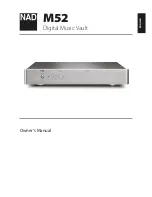
Reference
22
Agilent InfiniiVision 2000 X-Series Oscilloscopes User's Guide
291
Waveform Header
It is possible to store more than one waveform in the file, and each
waveform stored will have a waveform header. When using segmented
memory, each segment is treated as a separate waveform. The waveform
header contains information about the type of waveform data that is
stored following the waveform data header.
Header Size
A 32-bit integer that is the number of bytes in the header.
Waveform Type
A 32-bit integer that is the type of waveform stored in the file:
• 0 = Unknown.
• 1 = Normal.
• 2 = Peak Detect.
• 3 = Average.
• 4 = Not used in InfiniiVision oscilloscopes.
• 5 = Not used in InfiniiVision oscilloscopes.
• 6 = Logic.
Number of
Waveform
Buffers
A 32-bit integer that is the number of waveform buffers required to read the
data.
Points
A 32-bit integer that is the number of waveform points in the data.
Count
A 32-bit integer that is the number of hits at each time bucket in the waveform
record when the waveform was created using an acquisition mode like
averaging. For example, when averaging, a count of four would mean every
waveform data point in the waveform record has been averaged at least four
times. The default value is 0.
X Display Range
A 32-bit float that is the X-axis duration of the waveform that is displayed. For
time domain waveforms, it is the duration of time across the display. If the
value is zero then no data has been acquired.
X Display Origin
A 64-bit double that is the X-axis value at the left edge of the display. For time
domain waveforms, it is the time at the start of the display. This value is
treated as a double precision 64-bit floating point number. If the value is zero
then no data has been acquired.
X Increment
A 64-bit double that is the duration between data points on the X axis. For
time domain waveforms, this is the time between points. If the value is zero
then no data has been acquired.
X Origin
A 64-bit double that is the X-axis value of the first data point in the data
record. For time domain waveforms, it is the time of the first point. This value
is treated as a double precision 64-bit floating point number. If the value is
zero then no data has been acquired.
Summary of Contents for 2000 X-Series
Page 1: ...s1 Agilent InfiniiVision 2000 X Series Oscilloscopes User s Guide ...
Page 20: ...20 Agilent InfiniiVision 2000 X Series Oscilloscopes User s Guide ...
Page 44: ...44 Agilent InfiniiVision 2000 X Series Oscilloscopes User s Guide 1 Getting Started ...
Page 58: ...58 Agilent InfiniiVision 2000 X Series Oscilloscopes User s Guide 2 Horizontal Controls ...
Page 66: ...66 Agilent InfiniiVision 2000 X Series Oscilloscopes User s Guide 3 Vertical Controls ...
Page 80: ...80 Agilent InfiniiVision 2000 X Series Oscilloscopes User s Guide 4 Math Waveforms ...
Page 104: ...104 Agilent InfiniiVision 2000 X Series Oscilloscopes User s Guide 6 Digital Channels ...
Page 110: ...110 Agilent InfiniiVision 2000 X Series Oscilloscopes User s Guide 7 Serial Decode ...
Page 116: ...116 Agilent InfiniiVision 2000 X Series Oscilloscopes User s Guide 8 Display Settings ...
Page 152: ...152 Agilent InfiniiVision 2000 X Series Oscilloscopes User s Guide 11 Trigger Mode Coupling ...
Page 178: ...178 Agilent InfiniiVision 2000 X Series Oscilloscopes User s Guide 13 Cursors ...
Page 214: ...214 Agilent InfiniiVision 2000 X Series Oscilloscopes User s Guide 16 Digital Voltmeter ...
Page 226: ...226 Agilent InfiniiVision 2000 X Series Oscilloscopes User s Guide 17 Waveform Generator ...
Page 244: ...244 Agilent InfiniiVision 2000 X Series Oscilloscopes User s Guide 19 Print Screens ...
Page 280: ...280 Agilent InfiniiVision 2000 X Series Oscilloscopes User s Guide 21 Web Interface ...
Page 352: ...352 Agilent InfiniiVision 2000 X Series Oscilloscopes User s Guide Index ...















































